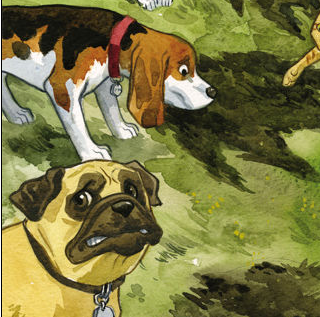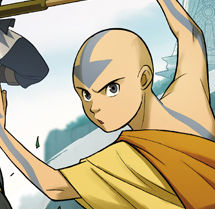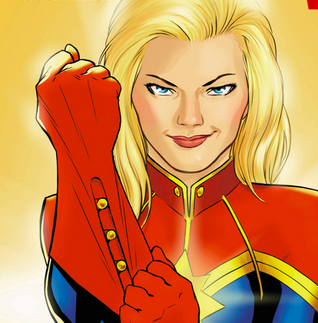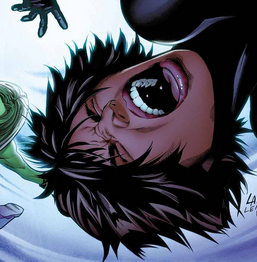Deadshirt Is Reading… is a weekly feature in which Deadshirt’s staff, contributing writers and friends-of-the-site offer their thoughts on a diverse array of comics, from name-brand cape titles to creator-owned books to webcomics.
Christina Harrington is reading…
Written by Kelly Sue DeConnick
Art by David Lopez (pencils) and Lee Loughridge (colors)
Letters by VC’s Joe Caramagna
Marvel
“Higher, Further, Faster, More.”
The premise for this new arc of Captain Marvel? Avengers, but in SPACE. Prompted by an alien named Tic falling out of the sky, Tony Stark approaches the good Captain about a new posting, where she’ll act as a liaison for the Avengers while helping the do-gooders on the other side of the galaxy. Dealing with memory loss and other after-effects of Inhumanity, Carol decides that a little time on her own might be for the best. We’re treated to a fast forward in the very beginning of the issue showing the Captain in the midst of crime fighting on an alien world and it doesn’t look easy.
The #1 on the front cover of this book is misleading. It’s not a reboot. This is definitely a continuation of the previous Captain Marvel comic, including carrying over the previous writer/possible goddess-of-old Kelly Sue DeConnick. However, you don’t need to read any previous Captain Marvel issue to be able to understand and enjoy this one. It’s a smart move, allowing old readers the satisfaction of long-term story arcs, while providing much needed entry points to new readers.
In this way, the Captain Marvel #1 of March 2014 continues the spirit found in Captain Marvel #1 of July 2012, when Carol Danvers was finally allowed to drop the name of Ms. Marvel and step into her own. The new name and new costume design (a superheroine in pants! WHAAAAAT!) put the character and her writer at the forefront of a growing movement of fans and creators demanding more inclusivity in comics. It’s good to see this creative team continue that spirit of inclusivity by making this issue as accessible as possible, while maintaining a richly developed cast and world.
Max Robinson is reading…
 Beasts of Burden: Hunters and Gatherers (one-shot)
Beasts of Burden: Hunters and Gatherers (one-shot)
Written by Evan Dorkin
Art by Jill Thompson
Dark Horse
“RAT KINGDOM! RAT KINGDOM!”
The semi-annual appearance of a new Beasts of Burden story from Dorkin and Thompson is always welcome and this week’s “Hunters and Gatherers” is a solid, if odd installment. After a thrilling opening half that pits the Beasts against an unseeable monster (Thompson kills this, there’s something really unnerving about watching various animals gets wounded or outright CRUNCHED by seemingly nothing), this issue opts to give the reader a glimpse of what the cast do in between facing the supernatural.
On one hand, this is pretty novel; Dorkin highlights the evolving relationship between our heroes and the community they serve as well as some troubling changes within (the usually plucky terrier Whitey wonders what it must feel like to get eaten much to everyone’s discomfort). The downside is that the issue feels sort of anticlimactic since it pumps the breaks midway through. I suspect it’ll read better collected.
That said, I appreciate the “calm before the storm” vibe and with the way the last few pages tease some seriously creepy bad news, the wait for the next chapter is going to be even harder.
Written by Al Ewing
Art by Valerio Schiti (pencils) and Frank D’Armata (colors)
Letters by VC’s Cory Petit
Marvel
“You want a deal? This is your deal: Give me everything you have. Now. Or crawl away and die and I’ll do it without you.”
Ewing and Schiti’s Mighty Avengers is going strong with this eighth issue that serves as a partial epilogue for last issue’s amulet induced-White Tiger rampage before shifting the focus onto forgotten elder statesman hero The Blue Marvel. Artwise, Schiti continues to be a welcome (if not extraordinarily exciting) relief after the first handful of Greg Land-stenciled issues. Storywise, Ewing continues to make you feel like you’re reading a really good Bronze Age Marvel book; it feels like we’re catching the characters in the midst of a really busy week and I can’t remember the last time I read a modern day superhero book that used so many “Editor’s Note” boxes. Further props for managing to balance the soap opera element that’s so crucial to a book like this (THIS ISSUE: THE SINS OF BLUE MARVEL’S PAST COME BACK TO HAUNT HIM) with some really funny gags (She-Hulk trash talking some really dorky killer robot wasps and jacking their ray guns).
My favorite part of this issue hands down is White Tiger’s verbal face off with the tiger god that serves as her supernatural benefactor; it’s genuinely surprising, tense and pays off a sidestory Ewing’s been working on from issue one.
My one major gripe with this month’s Mighty Avengers is that the aforementioned Blue Marvel reveal, while interesting, is semi-dependent on you having read a fairly obscure mini-series from 2008 to have the full effect. But you could argue that fits in with the throwback 70’s-80’s feel of Mighty; it harkens back to a time when comics just expected new readers to just roll with information overload.
Joe Stando is reading…
Written by Fred Van Lente
Art by Cory Smith (pencils and inks) and Mauricio Wallace (colors)
Dynamite
“The easiest way to make someone a slave is to convince them that’s all they deserve.”
Magnus, Robot Fighter isn’t new, he’s actually a very old Golden Age hero. Born into a world where humans are enslaved by machines, he was taught principles of liberty and justice by the computer 1A, and sent out to set things right. He was also taught a special fighting technique that made his hands strong enough to bust some robot heads. It was fun, in a Flash Gordon-y sort of way, and more importantly for our purposes, it lapsed into public domain. That means that several companies have put collected editions of the classic stories (which I highly recommend), but it also means that every so often a publisher takes another crack at the character.
The current run by Smith and Van Lente opens with a bang. Here, Magnus is raised is a Matrix-like simulated paradise by 1A, where humans and robots live together harmoniously. He’s unexpectedly and unwillingly pulled out into a strange, alien future full of robots who look like humans and robots who don’t look like humans and a couple that are in-between. The colors and layouts are explosive, and it’s one of the first comics I’ve read in a long time that feels “loud.” Van Lente has wisely played the concept mostly straight, which I like because it helps us connect with the character. Magnus is a fish out of water, scared and combative, but we’ve seen that he’s a good man with a strong, Superman-like set of values that will help and hinder him.
That’s not to say that this comic is too dour or serious. It’s still a story about a man who fights robots, and the fight scenes are suitably explosive and over the top. In the issue’s funniest sequence, Magnus is identified as a rogue unregistered human when a robot working an information kiosk has him read a Captcha code out loud. Little moments like this are a good way to keep the book from being too self-serious without descending into parody. It’s an extremely solid update to one of my favorite forgotten Golden Age characters (right up there with Whiz Wilson and U.S. Jones –hopefully they’ll be getting reboots soon), and I can’t recommend it enough.
Kayleigh Hearn is reading…
 Avatar: The Last Airbender: The Rift Part One
Avatar: The Last Airbender: The Rift Part One
Written by Gene Luen Yang
Art by Gurihiru
Dark Horse
“Not everyone’s past is like yours, Aang. Some of us have to run away just to…just to live.”
“The Rift” is the newest installment of Dark Horse’s continuation of the hit animated series, Avatar: The Last Airbender. In the Earth Kingdom, Aang has a vision of Avatar Yangchen which inspires him to celebrate an Air Nomad holiday that hasn’t been recognized in 100 years. He soon discovers that once sacred land is now owned by a refinery, and the ensuing culture clash creates a rift between Aang and one of his closest friends–Toph.
After the convoluted conclusion of The Search”, “The Rift” is a strong return to form. The stakes may not seem as high as in the previous volume, which resolved one of the show’s greatest mysteries, but the conflict leads to several strong character moments between Aang and Toph (the book still struggles to find a role for Katara besides being Aang’s girlfriend, unfortunately.) They face a fascinating, complex problem with no easy solution, and both sides are sympathetic; Aang wants to uphold the traditions of his lost people, while Toph rejects the constricting rules of the past. Tradition vs. Modernity is a sophisticated topic for a comic aimed at young readers, but it never feels condescending or talks down to its audience.
Gurihiru’s art is cute, charming, and faithful to the animated series. Gene Luen Yang has a solid grasp on the characters, though his Avatar books haven’t reached the heights of his original works, like Boxers & Saints. If you’re a fan of the original animated series (and Toph Beifong especially,) The Rift is an enjoyable bridge between Avatar: The Last Airbender and its sequel, The Legend of Korra.
Dylan Roth is reading…
By David Lapham
Image/El Capitan
“And then something unbelievable happened. But if I tell you, you got to swear to keep it a secret…”
David Lapham’s auteur black-and-white noir series Stray Bullets, which has been on hiatus since 2005, returned this week with a double dose – the continuation of the original series starting with #42 and the launch of this new spin-off title. Having literally zero knowledge of this series, I decided to test whether or not this new book would be accessible to a new reader such as myself.
This issue takes place in 1978 and centers around Eli, an awkward kid of about fourteen, going through an unusual sexual awakening as he stows away in his father’s car on a visit to a strip club. There he befriends a Scotty, a too-cool tough guy in his twenties, and witnesses him taking care of some violent business. Without giving too much away, a mystery involving people close to Eli begins to unfold, he ends up knowing things he shouldn’t be knowing, and it complicates his life in ways he couldn’t possibly be prepared for.
Despite my complete lack of prior experience with Stray Bullets, I had no difficulty following what seems to be an entirely new story in this series. Throughout the issue we’re attached closely to the perspective of Eli, himself totally ignorant to the shady world going on around him, learning only the bits and pieces of the story that he does. There’s a gritty crime story going on in this issue, but the focus of the story is totally on this kid and his attempt to process the unusual violent and sexual stimuli he’s being exposed to. It’s hard to judge the story just based on the first issue – I’m not sure yet how to interpret the role of sex and gender in this book, for instance – but I’m intrigued enough to commit to the next issue.





